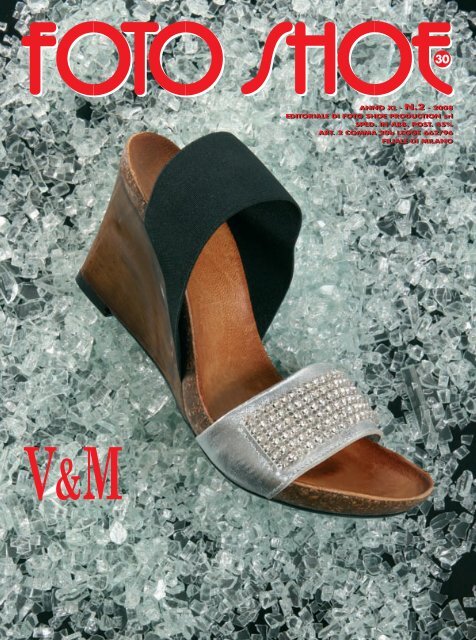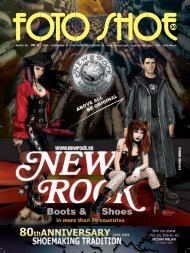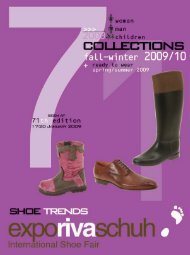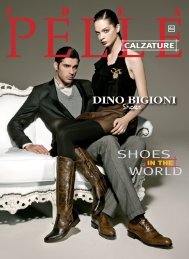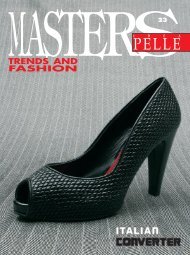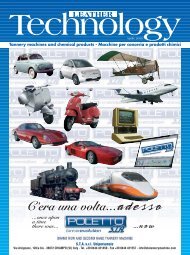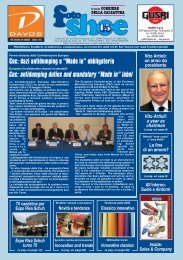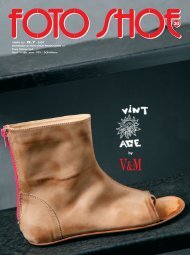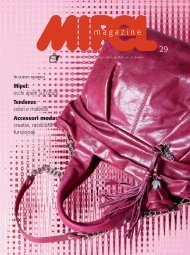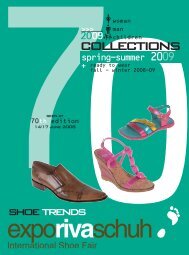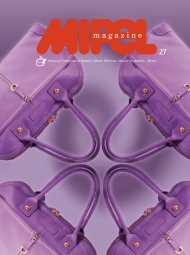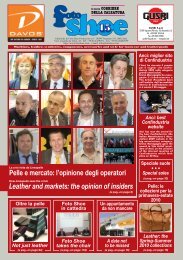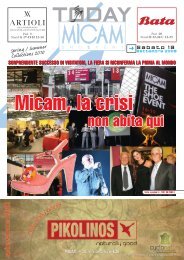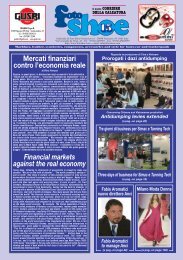ANNO XL - Editoriale di Foto Shoe Srl
ANNO XL - Editoriale di Foto Shoe Srl
ANNO XL - Editoriale di Foto Shoe Srl
- No tags were found...
You also want an ePaper? Increase the reach of your titles
YUMPU automatically turns print PDFs into web optimized ePapers that Google loves.
<strong>ANNO</strong> <strong>XL</strong> - N.2 - 2008EDITORIALE DI FOTO SHOE PRODUCTION srlSPED. IN ABB. POST. 45%ART. 2 COMMA 20b LEGGE 662/96FILIALE DI MILANO
EDITORIALE DIFOTO SHOE PRODUCTION SRLVia Leonardo da Vinci, 4320090 Trezzano sul Naviglio (MI) ItalyTel. 0039/02.445.90.91 r.a.Fax 0039/02.48402959http://www.fotoshoe.come.mail: info@fotoshoe.comCONTENTSSOMMARIOE<strong>di</strong>tor: Fabrizio Nar<strong>di</strong>niYear XXXX n. 2 febbraio 2008Calzaturificio V.M. EXPORT s.r.l.Via S. Cristoforo, 9255013 LAMMARI - Capannori (LU) ItalyTel. +39 0583.962094 - 961827Fax +39 0583.961827Esponiamo a/We exhibit at:MICAM MilanoPad. 7 - Stand C 12/16Publishing <strong>di</strong>rector: Lorenzo RaggiConsultant e<strong>di</strong>tor: Rino PanseriE<strong>di</strong>torial staff:Paola Palmieri, Barbara SoliniArt <strong>di</strong>rector: Rino CavallaroGraphics and production: Rosanna VillaPaging-up: Martina Donà,Pier Luigi Fasolin, Stu<strong>di</strong>o Elleci, Elena Viola,Photo: Matteo Galuzzi, Stu<strong>di</strong>o SoliStyling: Anna TrudenMake-up: Laura PugnalinPromotion coor<strong>di</strong>nator: Elisa TrasiE<strong>di</strong>torial Manager: Alberto MolteniPromotion: Filippo Crepal<strong>di</strong>Luciano Di Marzo, Pier Nicola Fascetto,Giuseppe PiccoInternational PromotionGabriella Laino, Lucio Luiselli,Enza MasottiPublic RelationsAlberto GattiL’abbonamento per l’Italia può essereEuropean richiesto chiamando <strong>di</strong>rettamente<strong>Shoe</strong> Pressi nostri uffici.AssociationSole Agent for Distribution Abroad:A.I.E. Agenzia Italiana <strong>di</strong> Esportazione S.p.A.Via Manzoni, 12 - 20089 Rozzano (MI) - ItalyPh.: 0039/02.57512575Fax 0039/02.57512606Printing: Ponzio - OlonaCopiano (PV)Socio USPI - Aut. del trib. <strong>di</strong> Milanon. 392 del 5-12-69Spe<strong>di</strong>zione in abbonamento postale.Pubblicità inferiore al 45%, su base annua.E’ vietata la riproduzione senza autorizzazionedei testi e delle immaginiIl trattamento dei dati personali deidestinatari <strong>di</strong> <strong>Foto</strong> <strong>Shoe</strong> 30 è svolto nel rispettodella legge 675/96 sulla Privacy.È possibile chiedere la mo<strong>di</strong>fica o la cancellazionedei propri dati in<strong>di</strong>rizzando la richiesta a:EDITORIALE DI FOTO SHOE PRODUCTION SRLsede <strong>di</strong> Via Leonardo da Vinci, 4320090 Trezzano sul Naviglio - Milano - Italyai numeri <strong>di</strong> fax e <strong>di</strong> posta elettronica soprain<strong>di</strong>cati.Calzature: confermato il trend positivo – Anci reports on the economic situation 16Cresce il numero dei visitatori – Rising numbers of visitors 22Riapre le porte il Casinò <strong>di</strong> Arco – The doors of Arco’s casino re-open 24Ispirazione estate – Summer inspiration 58Raffinatezza e comfort – Elegance and comfort 66Comode ma alla moda – Comfortable but stylish 80Fascino e seduzione del tacco a spillo – Glamour and Allure of the Stiletto Heel 86Bianco e nero a contrasto – Contrasting black and white 94Abicalçados: un nuovo logo per l’Anniversario – Abicalcados: a new logo to celebrate 96Grazia ed eleganza tutte femminili – Total feminine grace and elegance 98Moda e tecnologia si incontrano – Fashion meets technology 100Debutta Pitti W Woman a Firenze – Pitti W Woman debuts in Florence 102Colori in libertà – Flying colours 160Pitti Uomo: confermala ripresa – Pitti Uomo:confirming upward trends 170La Cina, dagli occhi dell’esperto – China, seen through expert eyes 180Una manifestazione sempre più vivace – An increasingly lively event 184Decima e<strong>di</strong>zione <strong>di</strong> Jinjiang Footwear Exposition – 10 th Jinjiang Footwear (Int’l) Exposition 188Mosshoes: la calzatura in mostra – Mosshoes: footwear goes on <strong>di</strong>splay 190Sesta e<strong>di</strong>zione <strong>di</strong> Dongguan China<strong>Shoe</strong>s – China<strong>Shoe</strong>tec – The 6 th DongguanChina <strong>Shoe</strong>s – China<strong>Shoe</strong>tec exhibition192Si ringrazia per la gentile collaborazione:Stu<strong>di</strong>o OUTLINE Stu<strong>di</strong>o RES Stu<strong>di</strong>o YOUR IMAGE Stu<strong>di</strong>o LOOKRipa <strong>di</strong> Porta Ticinese, 7 Via Tortona, 18 Via Marcona, 3 Via Argelati, 40/A20100 MILANO 20100 MILANO 20100 MILANO 20100 MILANOTel. 02.58.10.80.21 Tel. 02.58.10.53.08 Tel. 02.54.05.01.77 Tel. 02.89.42.18.70FOTOSHOE 7
InterviewGermano Ercoli, presidente Confindustria <strong>di</strong> Macerata - Germano Ercoli, Chairman of the Macerata Manufacturing AssociationCHI FARÀ ANCORA LE SCARPE IN ITALIA?Who will continue to manufacture footwear in Italy?Marche: un mondoimpren<strong>di</strong>toriale composito,ricco, <strong>di</strong>namico,che si è dovuto confrontarecon le nuovesituazioni del mercatoaccettandone le sfide.Un tessuto produttivo,quello marchigiano, nelquale spiccano impren<strong>di</strong>tori<strong>di</strong> spessore, abituati aguardare in faccia larealtà con la quale si confrontanoquoti<strong>di</strong>anamentee, dalla quale, traggonopreziosi insegnamenti.Uno <strong>di</strong> questi è indubbiamenteGermano Ercoli,titolare <strong>di</strong> Eurosuole ePresidente <strong>di</strong> ConfindustriaMacerata.“Macerata – è il parere <strong>di</strong>Ercoli – anche se non è alprimo posto <strong>di</strong> un’ipoteticaclassifica fra le provinciepiù produttive, è untipico esempio <strong>di</strong> quelloche rappresenta la realtàmarchigiana non solo inItalia ma in tutto ilmondo. Questo perchè,in una fase <strong>di</strong> globalizzazionepesante e <strong>di</strong>fficile,in un momento in cui imercati subiscono tumultuosiavvenimenti quali,per esempio, il valoredell’Euro rispetto al dollaroe l’impennata del prezzodel petrolio, con ripercussionidevastanti sull’economia,non abbiamoregistrato <strong>di</strong>sastri e contraccolpipesanti.Anzi, a livello regionale,c’è stato un incrementogeneralizzato dell’export,superiore ad altre regionipiù industrializzate”.Perché tutto ciò?Secondo Ercoli la ragione“ va ricercata nel tessutoindustriale della nostraarea fatta <strong>di</strong> piccole eme<strong>di</strong>e aziende che hannosaputo reagire con forzaed intelligenza adeguandosialle nuove situazioni<strong>di</strong> mercato con la flessibilitàche le ha sempre contrad<strong>di</strong>stinte.Abbiamoassistito ad una risposta<strong>di</strong>namica e forte che hafatto da barriera ad un’ondatamolto pesante. Cisono state anche realtàche hanno subito questocontraccolpo ma ciò èdovuto a situazioni aziendaliinterne decisamenteprecarie”.La struttura marchigianaha retto. Dove ha trovatotutte queste risorse?“Sino ad oggi siamo riuscitia resistere ma non èstato e non è attualmentefacile. Tanti sono i problemiche ci troviamo <strong>di</strong>fronte: uno, fra tutti, lacompagine governativache fa tutto tranne chegovernare. Purtroppo, il‘sistema Italia’ ci ha insegnato,in tutti questi anni,l’assoluto immobilismo ein<strong>di</strong>fferenza rispetto alleproblematiche impren<strong>di</strong>toriali.Una grossa spintaè venuta invece dalbasso, da quella realtà<strong>di</strong>strettuale che caratterizzanon solo le Marche maanche gran parte delnostro Paese dove è piùfacile aggiornarsi all’interno<strong>di</strong> una filiera operativa.Certamente la nostrazona è uno degli esempipiù eloquenti: non mirisulta infatti esistano altrearee così importanti perquanto riguarda il mondodelle suole dove, la specializzazioneha raggiuntolivelli invi<strong>di</strong>abili”.Ma ci deve essere qualcheelemento in più cheha aiutato il settore a resistereai nuovi ostacoliposti dal mercato“Certamente - è il pareredel Presidente <strong>di</strong> Confindustria<strong>di</strong> Macerata – esistonofattori che hannoaiutato le nostre aziende.Prima <strong>di</strong> tutto la grandede<strong>di</strong>zione al lavoro e lagrande genialità checaratterizza i nostriimpren<strong>di</strong>tori. E poi lacapacità innata <strong>di</strong> coinvolgerele maestranze neiprogetti industriali. Il rapportoche c’è da noi fratitolari e maestranze èunico: siamo cresciutiinsieme, abbiamo percorsoil cammino aziendaleinsieme e da parte dell’impren<strong>di</strong>toremarchigianoc’è gratitu<strong>di</strong>ne neiconfronti <strong>di</strong> chi, dall’operaioal <strong>di</strong>rigente, ha datoil meglio <strong>di</strong> sé per l’azienda”.Il settore italiano e quellomarchigiano non è sfuggitoalla regola della delocalizzazione.Cosa nepensa <strong>di</strong> questo fenomeno?“Si tratta <strong>di</strong> un fenomeno– continua Ercoli – vissutoper necessità e perriba<strong>di</strong>re la propria sopravvivenzain un mercatosempre più <strong>di</strong>fficile. Sitratta <strong>di</strong> un fenomeno cheha avuto, in molti casi,anche aspetti positivi conil potenziamento dellapropria realtà in Italia”.Alla luce <strong>di</strong> queste nuovesituazioni come vede ilfuturo del settore calzaturiero?“La situazione non è dellepiù ottimistiche - affermail titolare <strong>di</strong> Eurosuole –Io sono molto preoccupatoper il futuro e mi sorgonospontanee alcunedomande. Chi farà ancorale scarpe in Italia? Dopoquesta generazione cosasuccederà? La realtà parla,purtroppo, <strong>di</strong> una cronicacarenza <strong>di</strong> personale aqualsiasi livello e se nonsi ha a <strong>di</strong>sposizione unamanodopera giusta e qualificataè <strong>di</strong>fficile prevedereun futuro positivo. E’un problema enorme chevede le istituzioni assolutamenteassenti in fatto <strong>di</strong>interventi concreti. Civogliono le scuole adatteper introdurre i giovaninelle nostre aziende epermettere loro <strong>di</strong> calarsinelle varie realtà produttive.Noi siamo pronti adaccogliere i giovani perfar capire loro che il lavoroin fabbrica è nobile eimportante, ma la sensazioneè che il nostro allarmenon sia raccolto danessuno”.Rimanendo nel tema delmercato globale, comegiu<strong>di</strong>ca il fenomeno Cina?“Il <strong>di</strong>scorso Cina non puòprescindere dalla suasituazione politica caratterizzatada mille incogniteper il suo futuro <strong>di</strong> cui è<strong>di</strong>fficile prevederne glisviluppi.La mia sensazione, perquanto riguarda il nostrosettore, è che questoaccanimento industrialesu un prodotto ‘povero’quale è la scarpa siadestinato ad esaurirsi. Icinesi non sono calzaturieriper vocazione come inostri, sono dei finanzieriche hanno ritenuto <strong>di</strong> farebusinnes con le calzature.Appunto, finchè riterranno<strong>di</strong> fare businnes. Iocredo si in<strong>di</strong>rizzerannoverso settori più strategicie più sofisticati.FOTOSHOE15 6
InterviewPer quanto riguarda lacapacità <strong>di</strong> assorbimentodelle nostre calzature,penso che le opportunitàci siano già adesso e, inun periodo a breve,anche per il prodotto <strong>di</strong>fascia me<strong>di</strong>a”.Torniamo alla realtà chevede Ercoli al timone dapiù <strong>di</strong> 30 anni: Eurosuole,un’azienda <strong>di</strong>ventata leadernel suo comparto.Qual è il segreto?“Non ci sono segreti nelnostro cammino – concludegermano Ercoli –Abbiamo dovuto affrontarei problemi come tutti.Quello che abbiamo cercato<strong>di</strong> fare è <strong>di</strong> essereorganizzati il più possibilepassando attraverso continuiinvestimenti ed innovazioni.Abbiamo procedutoanche ad una ristrutturazionedel prodotto<strong>di</strong>versificando la clientela.Tutto questo ha portatoad importanti e tangibilirisultati, per adesso in termini<strong>di</strong> visibilità e posizionamentosul mercato,nell’imme<strong>di</strong>ato futuro ciauspichiamo in terminired<strong>di</strong>ttuali”.The Marche region: avaried, rich anddynamic entrepreneurialworld that hashad to contend with newmarket situations andaccept the challenges.The Marche region’s productionindustry hassome outstan<strong>di</strong>ng entrepreneurswho are used tofacing up to reality anddealing with it on a dailybasis, thus gaining preciousexperience.One of these is undoubtedlyGermano Ercoli,owner of Eurosuole andChairman of the MacerataManufacturing Association.Accor<strong>di</strong>ng to Mr. Ercoli,“Although not at the topof a hypothetical chart ofthe most productiveprovinces, Macerata is atypical example of whatthe Marche region represents,not only in Italy butin the rest of the world.This is because, in a complexphase of extensiveglobalisation, at a timewhen markets are affectedby instabilities, like, forexample the value of theEuro against the dollarand the steep rice in theprice of petrol, with devastatingrepercussions onthe economy, we have notregistered heavy losses ora backlash.In fact, on a regionallevel, there has been ageneral increase inexports, above that of themore industrialisedregions.”Why is this?In Mr. Ercoli’s opinion,“The reason lies in theindustrial make-up of ourarea, which consists ofsmall and me<strong>di</strong>um companiesthat managed toreact forcefully and intelligently,adapting to thenew situations of themarket with the flexibilitythat has always <strong>di</strong>stinguishedthem. We saw adynamic and strenuousresponse that acted as abarrier against this tidalwave. Some companiessuffered the backlash butthis was due to internalcompany situations thatwere already very precarious.”The Marche region’sstructure held fast.Where <strong>di</strong>d it find all theresources?“We have managed tohold out until now, but ithas not been easy and atpresent things are no better.We are faced withmany problems, inclu<strong>di</strong>ngthat of a governmentstructure that has doneeverything except govern.Throughout the years, the“Italian system” hastaught us that, unfortunately,there is total in<strong>di</strong>fferenceand apathytowards entrepreneurialproblems. Help camefrom further south, froma regional industry thatnot only characterises theMarche region but alsomost of the country,where it is easier to keepabreast of things withinan operative chain. Certainlyour area is one ofthe most eloquent examples:in fact I don’t knowof any other area that isas important for sole production,where specialisationhas reached enviablelevels.”There must be somethingelse that has helped theindustry withstand thenew obstacles created bythe market.“Certainly,” said Mr.Ercoli, “there are factorsthat have helped our companies.First of all, thede<strong>di</strong>cation and resourcefulnessthat characterisesour entrepreneurs, followedby the innate abilityto get skilled workersinvolved in industrialprojects. The relationshipbetween owners andskilled workers is unique:we have grown together,paced the same companypath and the entrepreneursfrom the Marcheregion are extremelygrateful to workers andmanagers who have giventheir all for their companies.”The Italian sector andthat of the Marche region<strong>di</strong>d not escape the rule ofrelocation. What do youthink of this phenomenon?“That it is a phenomenon,”continues Mr.Ercoli, “arising from thenecessity to survive in anincreasingly <strong>di</strong>fficultmarket. It is a phenomenonthat, in many cases,has had positive aspectswith the strengthening ofentrepreneurs’ own companiesback home.”In light of these new situations,how do you see thefuture of the footwearmanufacturing industry?“The situation is not oneof the rosiest,” confirmsEurosuole’s owner, “I amvery worried about thefuture and a few questionsspring to mind.Who will still be makingshoes in Italy? What willhappen after this generationhas gone? Unfortunately,the reality is thatthere is a chronic lack ofpersonnel on every level,and without the right,skilled labour it is <strong>di</strong>fficultto envisage a positivefuture. This is a hugeproblem in which theinstitutions are takingabsolutely no interest, norare they actively doinganything about it. Weneed suitable schools tointroduce young people toour firms and give theman opportunity to get toknow the various productiverealities. We areready to welcome theyoung and help them tounderstand that work ina factory is <strong>di</strong>gnified an<strong>di</strong>mportant but we feel thatour alarm signals will notbe heard by anyone.”Still on the theme of theglobal market, how doyou see the China phenomenon?“The China problem cannotsway from a politicalsituation characterised bythousands of unknownfactors of which it is <strong>di</strong>fficultto foresee developments.As far as our industry isconcerned, my feeling isthat this industrial attackon a “poor” product likethe shoe is destined tocease. Unlike the Italians,the Chinese are notfootwear manufacturersby vocation, they arefinancial experts whothought footwear was bigbusiness and they willcontinue along this pathas long as it is profitableto them. I believe theywill soon turn to moresophisticated and strategicsectors.As far as the ability toabsorb our footwear isconcerned, I think thatthe opportunities arealready there and that itwill not be long before themid bracket also gets ahold.”Let’s get back to the firmthat sees Mr. Ercoli at thehelm for over 30 years:Eurosuole, a business thathas become a leader in itsfield. What is the secret?“There are no secrets,”concludes Mr. Ercoli. “Wehave had to face problemslike everyone else. Whatwe have tried to do is tobe as organised as possible,with continuousinvestments and innovation.We have also reorganisedthe product inorder to <strong>di</strong>versify ourclientele. All of this hasled to important and tangibleresults, for now interms of giving us a higherprofile and placing onthe market; but in theimme<strong>di</strong>ate future we hopein terms of income. ”FOTOSHOE15 7
MeetingsAnci presenta i dati congiunturali - Anci reports on the economic situationCALZATURE: CONFERMATO IL TREND POSITIVOFootwear: positive trends confirmedDopo un triennio <strong>di</strong>fficile,il settore calzaturieroitaliano nelprimo semestre 2007 hamostrato i primi segnali <strong>di</strong>recupero. Il trend positivoè riconfermato dalla notacongiunturale elaboratadall’Ufficio Stu<strong>di</strong> <strong>di</strong> Anci(associazione nazionalecalzaturieri italiani) per ilterzo trimestre 2007, cheregistra la crescita delsaldo commerciale, deiprezzi e delle esportazionidelle calzature italiane.“In questi ultimi annimolte imprese hanno soffertola crisi – ha <strong>di</strong>chiaratoVito Artioli, presidenteAnci – ma il settore nelcomplesso è riuscito a trovareil bandolo dellamatassa anche attraversoun ripensamento deimodelli <strong>di</strong> business.Diversificazione, internazionalizzazionee specializzazionenella fasciame<strong>di</strong>o-alta sono stati itrend che hanno caratterizzatole imprese chemeglio hanno saputo usciredalla crisi. Tuttavia, tragli in<strong>di</strong>catori per il me<strong>di</strong>otermine, si trovano ancoraluci ed ombre che nonconsentono <strong>di</strong> pensare <strong>di</strong>essere pienamente uscitidal guado”.Uno dei principali segnalifavorevoli al settore è ilritorno alla crescita delsaldo commerciale: sebbenenegli anni <strong>di</strong> crisi fosserimasto costantementesopra soglia 3.2 miliar<strong>di</strong> <strong>di</strong>euro, nei primi otto mesidel 2007 il surplus commercialeha sfiorato i 2.5miliar<strong>di</strong> <strong>di</strong> euro, con unacrescita del 15.3% sull’analogoperiodo del 2006.Un dato che, seppur ri<strong>di</strong>mensionatoad un effettivo+7.7% in valore, dopola depurazione statisticadei flussi da Romania eBulgaria, dal 1° gennaio2007 soggetti ad unanuova metodologia <strong>di</strong>rilevazione, è significativo.Positive anche le <strong>di</strong>namichedei prezzi alla produzioneche, dopo <strong>di</strong>versianni in stallo, aumentanodel +3% sul mercato internoe +2.6% su quelli esteri.Un ritocco verso l’altoche riguarda anche i listiniprezzi delle esportazioni,con prezzi me<strong>di</strong> che cresconodel +6.6%, segnodella mo<strong>di</strong>fica <strong>di</strong> gammadell’offerta e del generaleriposizionamento versol’alto delle aziende italiane.I flussi delle esportazioniaumentano conseguentementedel +9.6% nei valorie del +2.9% nei quantitativi:in totale, nei primiotto mesi dell’anno, sonostati esportati 178.5 milioni<strong>di</strong> paia <strong>di</strong> calzature, 5milioni in più rispetto al2006, per un valore complessivo<strong>di</strong> 4.805 milioni<strong>di</strong> euro. Se da un latoaumentano i valori delleesportazioni su quasi tuttii mercati tra<strong>di</strong>zionali <strong>di</strong>sbocco del made in Italy –Germania (+3.7%) e Usa(+0.8%) compresi, conperformance buone inFrancia (+6.7%), RegnoUnito (+10.9%) e Spagna(+12.8%) -, dall’altro siregistra la ripresa delladomanda del mercatointerno (+6.1% in quantitàe +9.2% in valore). Unsegnale che tuttavia nonva preso con eccessivoottimismo, visto che sitratta soprattutto <strong>di</strong> acquistirimandati nelle scorsestagioni. Crescono ancora,inoltre, le importazionidel +11.9% in quantità afronte <strong>di</strong> una significativa<strong>di</strong>minuzione dei prezzime<strong>di</strong> (-6.9%). Complessivamentenei primi ottomesi del 2007 sono entratinel nostro mercato ben298.6 milioni <strong>di</strong> paia <strong>di</strong>calzature per un valore <strong>di</strong>2.307 milioni <strong>di</strong> euro(+4.1%). Una <strong>di</strong>namicadeterminata soprattuttodalla pressione competitivadel Far East (anche seviziata dalle voci <strong>di</strong> subforniturae decentramentoproduttivo all’estero), inparticolare dalla Cina(+22.5%, con +11.4% delprezzo me<strong>di</strong>o) e dal Vietnam(+18.5, con prezzome<strong>di</strong>o -4.1%), nonostantela corrispettiva contrazionedelle voci <strong>di</strong> tomaio inpelle a causa delle misureantidumping europee(-14.4% in valore dallaCina e -5.2% dal Vietnam).Ma cosa riserverà il futuroal settore calzaturiero italiano?Secondo Anci nulla<strong>di</strong> eclatante: “Problemistrutturali impe<strong>di</strong>sconoalle imprese <strong>di</strong> confermarel’ottimismo anche per ilprossimo anno” è il commento<strong>di</strong> Vito Artioli conseguentesia ai dati suglior<strong>di</strong>nativi (+0.7% in quantità,con un +2.2% in Italia,al <strong>di</strong> sotto dei livellidel terzo trimestre 2007),sia i dati sull’occupazione,che non si sono riallineatial buon andamento del2007 (in calo sia addetti,che imprese del settore).“Manca la fiducia delleimprese a fronte <strong>di</strong> unaforte instabilità sia sulmercato interno che suquelli esteri –concludeVito Artioli – Prevalgono itimori <strong>di</strong> un rallentamentodella domanda mon<strong>di</strong>ale,mentre sul mercato internopesa la forte incertezzapolitica e il perdurare <strong>di</strong>una non brillante situazioneeconomica delle famiglieitaliane”.FOTOSHOE15 10
MeetingsAfter a <strong>di</strong>fficult threeyearperiod, in thefirst six months of2007 the Italian footwearmanufacturing industryshowed its first signs ofrecovery. This positivetrend is reconfirmed inthe economic situationreport drawn up by theAnalysis Department ofAnci (national associationof Italian footwearmanufacturers) for thethird quarter of 2007,that registered a growthin the trade balance,prices and exports of Italianfootwear.“In recent years, manycompanies have sufferedfrom the prevailing crisis,”stated Anci’s Chairman,VitoArtioli, “but onthe whole the industrymanaged to find a solutionto the problem, whichincluded the reorganisationof business models.Diversification, internationalisationand specialisationin the mid-toprange were the characteristicsof the companiesthat best managed toovercome the crisis.Nonetheless, in the midtermthere are still a lot ofundefined areas whichin<strong>di</strong>cate that the industryis not completely out ofthe mire.”One of the most positivesigns for the industry isthe return of a growingtrade balance: while inthe years of crisis it managedto remain constantlyabove the threshold of3.2 billion Euros, in thefirst eight months of 2007the trade surplus touched2.5 billion Euros with anincrease of 15.3% comparedto the same periodof 2006. Although it boilsdown to an effective+7.7% in value, after thestatistical revision of theinflux from Romaniaand Bulgaria, subject to anew method of gatheringinformation from 1 January2007, this figure issignificant.The trends of productionprices are also positiveand, after several stagnantyears, increase by3% on the domestic marketand 2.6% on foreignones. This rise also affectsprice lists of exports withaverage prices growing by6.6%, an in<strong>di</strong>cation of achange in the range ofoffer and a generalimprovement in the positionof Italian companies.Consequently, exportsincrease by +9.6% invalue and +2.9% inquantity: in the first eightmonths of the year a totalof 178.5 million pairs offootwear were exported, 5million more than in2006, for an overall valueof 4,805 million Euros.If on one hand exportvalues increase on almostall Italian production’smost tra<strong>di</strong>tional markets– inclu<strong>di</strong>ng Germany(+3.7%) and the UnitedStates (+0.8%), with goodperformances in France(+6.7%), the United Kingdom(+10.9%) and Spain(+12.8%) – on the otherhand the domestic marketalso shows a rise indemand (+6.1% in quantityand +9.2% in value).However, we should notbe too optimistic aboutthese figures since theymainly regard purchasesthat were put off fromprevious seasons.Imports grew by a further+11.9% in quantityagainst a significant dropin average prices (-6.9%).In the first eight monthsof 2007, some 298.6 millionpairs of footwearentered our market for avalue of 2,307 millionEuros (+4.1%). Thistrend was determinedabove all by competitivepressure from the Far East(although vitiated by subsupplie<strong>di</strong>tems and productionrelocatedabroad), in particular byChina (+22.5%), in spiteof the correspon<strong>di</strong>ng dropin footwear with leatheruppers due to the Europeanantidumping measures(-14.4% in valuefrom China and –5.2%from Vietnam).What does the future holdfor the Italian footwearmanufacturing industry?Accor<strong>di</strong>ng to Anci nothingtoo sensational:“Structural problems preventcompanies frombeing very optimisticabout next year” is howVito Artioli comments thesituation, having <strong>di</strong>gestedfigures regar<strong>di</strong>ng orders(+0.7% in quantity, witha +2.2% in Italy butbelow levels of the thirdquarter 2007), and thoseof unemployment that <strong>di</strong>dnot realign with the goodstart of 2007 (the industry’scompanies andemployees are on a downwardtrend).“Companies lack confidencedue to the greatinstability of both domesticand foreign markets,”concludes Vito Artioli.“Entrepreneurs fear a fallin world demand, whileuncertain policies and theprecarious situation ofItalian families weighheavily on the domesticmarket.”FOTOSHOE15 11
MeetingsRossano Sol<strong>di</strong>ni, presidente Fiamp - Rossano Sol<strong>di</strong>ni, Chairman of Fiamp“ SENZA DI NOI L’EUROPA SAREBBE PIÙ POVERA”“Without us Europe would be even poorer”Un consuntivo positivodopo alcuni resi <strong>di</strong>fficilida un contestocompetitivo complicatoanche dalle scelte <strong>di</strong> strategiacommerciale attuatein sede UE. Questo è ilbilancio che ha tracciatoRossano Sol<strong>di</strong>ni, presidente<strong>di</strong> Fiamp, la FederazioneItaliana dell’AccessorioModa e persona.I dati elaborati dalla FondazioneE<strong>di</strong>son per Fiampparlano chiaro: dopo un2006 in miglioramento,ma con luci ed ombre, leimprese italiane hannosaputo riprendersi ciò chel’andamento dei cambi ela forte competizioneasiatica avevano tolto. Neiprimi nove mesi del 2007le esportazioni sono tornatea crescere a ritmisignificativi per tutte lecinque merceologie checompongono il sistemaFiamp: cuoio (+6,1%),pelletteria e valigie(+16,7%), calzature ecomponenti (+2,7%)occhialeria (+14,1% )gioielleria (+19,1%). Nelcomplesso la crescitadelle esportazioni in valoreè stata del 9,5% rispettoall’analogo periododello scorso anno, per untotale che sfiora i 16miliar<strong>di</strong> <strong>di</strong> Euro. La crescita<strong>di</strong> 1,3 miliar<strong>di</strong> <strong>di</strong> Eurodelle esportazioni Fiampè superiore a quantosono cresciute le esportazionicomplessive <strong>di</strong> Greciae Danimarca insieme.“Il 2006-2007 è stato unbiennio <strong>di</strong> ripresa per ilsistema Fiamp nel suoinsieme – ha commentatoil presidente Sol<strong>di</strong>ni – purpermanendo <strong>di</strong>fficoltà inalcuni comparti, dovutesoprattutto alla concorrenzaasimmetrica asiaticae alla anomala deriva deicambi del dollaro e delloyuan cinese. Due elementiche tuttavia sono statipiù che controbilanciatidai fattori competitivi vincentidel Made in Italy.Abbiamo abbandonato leproduzioni <strong>di</strong> più bassovalore aggiunto concentrandocinei segmenti <strong>di</strong>fascia me<strong>di</strong>o-alta in cuisiamo sempre stati leaderincontrastati negli accessorifaschion a livellomon<strong>di</strong>ale. Una trasformazioneche le impresehanno fatto, pur in assenza<strong>di</strong> un’adeguata politicacommerciale UE e <strong>di</strong> unastrategia nazionale <strong>di</strong>rilancio industriale”.Un’assenza che, comesottolinea lo stu<strong>di</strong>o realizzatoda Fiamp, non ècomprensibile alla lucedell’importanza che ilsistema Fiamp italianorappresenta all’interno delcontesto economico europeo.L’Italia è il primo paese inambito UE con un exportglobale <strong>di</strong> 20 miliar<strong>di</strong> <strong>di</strong>IL SISTEMA FIAMPDATI STRUTTURALIEuro e un saldo attivo <strong>di</strong>oltre 11 miliar<strong>di</strong> <strong>di</strong> Euro:in tutti e cinque i settoridel sistema Fiamp, l’Italiaè <strong>di</strong> gran lunga il primopaese esportatore consal<strong>di</strong> commerciali nettamentesuperiori a tutti glialtri paesi UE. Il nostrosistema industriale manifatturieroè, per i settoriFiamp, il polo produttivoeuropeo più importanteoltre che quello che creamaggiore surplus commerciale.Mettendo a confrontoil saldo commercialedel sistema Fiampdella UE con quello italianosi osserva che nel2006 il deficit commercialedei 26 paesi senza l’Italiaè <strong>di</strong> 11,6 miliar<strong>di</strong> mentrecon i 5,3 miliar<strong>di</strong> <strong>di</strong>Euro del surplus commercialeitaliano, il deficiteuropeo si riduce a 6,3miliar<strong>di</strong> <strong>di</strong> Euro.“Senza il sistema Fiampitaliano – è sempre ilparere <strong>di</strong> Rossano Sol<strong>di</strong>ni– l’economia UE sarebbepiù povera nel senso chedovrebbe pagare un deficitmolto superiore senzal’Italia. Questi dati evidenzianol’assoluta leadershipeuropea degli accessoriFashion “made in Italy”anche perché gran partedegli accessori modadegli stessi gran<strong>di</strong> marchidel lusso francesi è fabbricatain Italia. Eppuremanca una vera e propriapolitica industriale e commercialeche sappia rilanciareil settore, anche se ilvalore aggiunto delleindustrie italiane Fiamp èparagonabile a quellogenerato dagli apparecchiper le telecomunicazionifrancesi e superiore all’industriaaerospaziale tede-Export 2006 (1) Valore aggiunto (2) Numero Numeromil.€ mil.€ Imprese (3) addetti (3)Calzature e componenti 7.577 3.342 13.220 138.592Pelletteria 2.403 980 7.025 36.571Preparazione e concia cuoio 3.569 1.272 2.563 31.666Occhialeria 2.029 1.165 902 19.235Gioielleria 4.462 1.112 10.486 50.012TOTALE FIAMP 20.040 7.870 34.196 276.076Fonte: elaborazione Fondazione E<strong>di</strong>son su dati Istat e Eurostat(1) dati Eurostat anno 2006 - (2) dati Eurostat anno 2004 - (3) Censimento Istat 2001FOTOSHOE15 14
Meetingssca o francese. Nonostanteciò, il nostro sistemaviene considerato menostrategico e meno importante:un errore <strong>di</strong> valutazioneche senza l’innovazionedelle nostre impresee l’intraprendenza deinostri impren<strong>di</strong>toriavremmo pagato a caroprezzo”.Dalla Federazione Fiampvengono perciò due fortirichieste, che si ispiranoai principi <strong>di</strong> legalità etrasparenza al sistemapolitico europeo e italiano.In particolare, rispetto alprimo, Fiamp chiede unamaggiore incisività nelcontrasto al <strong>di</strong>lagantefenomeno della contraffazione,sia attraverso maggioricontrolli sui prodottiimportati sia attraversoinchieste della Magistraturanei confronti <strong>di</strong> chi utilizzale merci contraffatein un sistema organizzato.“Non si riesce a comprendereper quale ragione –prosegue il presidenteFiamp – quando si tratta<strong>di</strong> prodotti alimentari,me<strong>di</strong>cine o giocattoli, lacontraffazione suscitasdegno, mentre quando siparla <strong>di</strong> prodotti modanon vi è la consapevolezzache i rischi <strong>di</strong> me<strong>di</strong>operiodo sono altrettantoalti, come <strong>di</strong>mostrano isempre più frequentiritrovamenti <strong>di</strong> prodottimodanocivi alla salutedei consumatori. Ancheper questo occorre agirecon sanzioni e multe piùcre<strong>di</strong>bili agli acquirenti:gli attuali 10mila eurosono inutili perché <strong>di</strong>fatto inesigibili”.La cultura della legalità è,tuttavia, un aspetto chedeve trovare un riscontroanche a livello internazionale,sottolinea Sol<strong>di</strong>ni“con politiche doganalibasate su criteri <strong>di</strong> reciprocitàperché è chi giocasenza applicare le regoleil vero protezionista”.Rispetto alla trasparenza,l’adozione <strong>di</strong> una normativasull’obbligatorietà delmarchio <strong>di</strong> origine per iprodotti importati nellaUE corrisponde allanecessità <strong>di</strong> equiparare ilmercato europeo a tuttele altre aree mercato delmondo che già adottanol’obbligatorietà dell’in<strong>di</strong>cazione<strong>di</strong> provenienzadei prodotti.“Sul tema – <strong>di</strong>chiara RossanoSol<strong>di</strong>ni – dobbiamoesprimere la nostra insod<strong>di</strong>sfazionecirca il fattoche il risultato non siastato ancora raggiunto.Un fatto inspiegabile, nonsolo perché sono numerosiormai i pronunciamentida parte delle istituzioniitaliane ed europeea favore <strong>di</strong> una etichettatura<strong>di</strong> origine, maanche perché il “made in”potrebbe far rientrare inItalia almeno il 30% <strong>di</strong> ciòche oggi è prodotto fuoridai confini nazionali.Infatti, molti <strong>di</strong> quelli cheora importano dall’esteronon potranno permettersi<strong>di</strong> far pagare a prezzi cosìelevati un prodotto fattoin Cina”:Fiamp quin<strong>di</strong> lamenta la<strong>di</strong>sattenzione per un sistemaproduttivo così importante,non solo in Italiama anche in Europa, epropone azioni specifiche<strong>di</strong> promozione commercialee industriale.“Sono due gli interventiche Fiamp ritiene urgenti– illustra il presidente – ilprimo riguarda le politiche<strong>di</strong> promozione internazionaledelle nostreproduzioni. Occorreintrodurre un principio <strong>di</strong>corrispondenza tra finanziamentipubblici e flusso<strong>di</strong> esportazioni, considerandoquesti ultimi comeun in<strong>di</strong>catore della competitivitàdei singoli settori.Focalizzare su settori chehanno <strong>di</strong>mostrato, anchein momenti congiunturali<strong>di</strong>fficili, la loro competitivitàsui mercati internazionali,come è avvenutoper il sistema Fiamp, nonè più un’opzione ma unanecessità”.Altrettanto prioritario, ilpresidente Fiamp considerail supporto alle piccolee me<strong>di</strong>e imprese delsettore per i costi dellacreatività, strumento prioritario<strong>di</strong> innovazione peri settori dell’accessoriomoda:” occorre un <strong>di</strong>segnoorganico <strong>di</strong> interventiagevolativi per la ricercacreativa e stilistica e <strong>di</strong>campionario. Sono questiinfatti gli strumenti concui l’offerta italiana si èconquistata la leadershipmon<strong>di</strong>ale in un mercatoglobale in cui prevale l’imitazioneo la standar<strong>di</strong>zzazione.Per i settori rappresentatida Fiamp, lacontinua innovazione sulprodotto costituisce lavera chance competitiva”.Rossano Sol<strong>di</strong>ni,Chairman of Fiamp,the Italian Federationof Fashion and PersonalAccessories reporteda positive final balanceafter many that had beenmade all the more <strong>di</strong>fficultby a complicatedcompetitive situation andcommercial strategiesdecided in EU headquarters.Figures drawn up forFiamp by the E<strong>di</strong>sonFoundation speak clear:after an improvement in2006, but still with manyuncertainties, Italianfirms managed to gainback what they had lostwith unfavourableexchange rates and fierceAsian competition. In thefirst nine months of 2007,exports of the five industriescomprised in theFiamp system once againbegan to grow at a significantrate: leather(+6.1%), leather goodsand luggage (+16.7%),footwear and components(+2.7%), glasses (+14.1%),jewellery (+19.1%). Comparedto the same periodlast year, the value ofexports increased by9.5%, reaching a total ofalmost 16 billion Euros.The growth of 1.3 billionEuros of Fiamp’s exportsexceeds that of exports ofGreece and Denmark puttogether.“On the whole, 2006-2007 was a two-year periodof recovery for theFiamp system,” commentedChairman Sol<strong>di</strong>ni,“although some sectorscontinued to experience<strong>di</strong>fficulties, due above allto the unequal Asiancompetition and incongruitiesarising from theexchange rates of the dollarand the Chinese Yuan.Nevertheless, these two elementswere more thancounterbalanced by thewinning competitivecharacteristics of “madein Italy” products. Weabandoned the productionof lower price rangesand concentrated on themid-high bracket wherewe have always beenunrivalled world leadersfor fashion accessories.Companies made thistransition without thebacking of an appropriateEU trade policy or anational strategy for anindustrial comeback.”This omission, highlighte<strong>di</strong>n Fiamp’s survey, isincomprehensible in lightof the importance that theItalian Fiamp system representswithin the contextof the European economy.Italy tops the EU chartswith global exports of 20billion Euros and a cre<strong>di</strong>tbalance of over 11 billionEuros: all five of theFOTOSHOE15 15
Meetings“ SENZA DI NOI L’EUROPA SAREBBE PIÙ POVERA”“Without us Europe would be even poorer”Fiamp system’s sectors putItaly in the lead as topexporting country with acre<strong>di</strong>t balance thatexceeds all other EUcountries. For the Fiampsectors, our industrialmanufacturing system isthe most important Europeanproduction pool aswell as the one that createsthe biggest trade surplus.Comparing the EUFiamp system to the Italianone you see that in2006 the trade deficit ofthe 26 countries, withoutcounting Italy, was 11.6billion while with the 5.3billion Euros of the Italiantrade surplus theEuropean deficit drops to6.3 billion Euros.“Without the ItalianFiamp system,” continuedRossano Sol<strong>di</strong>ni, “the EUeconomy would be muchpoorer since it wouldhave a greater deficit.These figures highlight theabsolute leadership of“made in Italy” fashionaccessories in Europe,bearing in mind thatmany French designerlabels’ fashion accessoriesare also made in Italy.Nonetheless, there is noreal industrial and commercialpolicy to relaunchthe sector,although the added valueof the Italian Fiampindustries can be comparedto that generatedby the French telecommunicationsdevices and issuperior to the Germanand French aerospaceindustries. In spite of this,our system is consideredless strategic and lessimportant: an error ofevaluation that we wouldhave paid dearly had itnot been for the innovationof our companiesand the resourcefulnessof our entrepreneurs.”Hence the Fiamp Federationhas two big requeststo make of the Europeanand Italian governmentregar<strong>di</strong>ng the principlesof legality and transparency.With regards to the first,Fiamp demands greaterincisiveness to combat thefar-reaching phenomenonof fake products,both through increasedcontrols of imported goodsand through Court investigationsinto those whouse fake goods in anorganised system.“We cannot understandwhy fake products arousesuch in<strong>di</strong>gnation,” continuedFiamp’s chairman,“when it comes to foodstuffs,me<strong>di</strong>cines and toys,while when it comes tofashion products no-oneis aware that the midtermrisks are equallyhigh, as demonstrated bythe increasingly frequent<strong>di</strong>scovery of fashion productsthat are harmful tothe consumer’s health.This is just another reasonwhy we must havemore convincing sanctionsand fines: the current10,000 Euros areuseless because they arein fact irrecoverable.”However, the culture oflegality is something thatmust also be tackled onan international level,stresses Mr. Sol<strong>di</strong>ni, “withCustoms policies based oncriteria of reciprocitybecause it is those whoplay without rules whoare the real protectionists.”When it comes to transparency,the adoption ofa norm making it compulsoryto <strong>di</strong>splay a labelof origin on goods importe<strong>di</strong>nto the EU meets withthe need to equalise theEuropean market with allthe other market areas ofthe world that alreadyadopt this mandatoryin<strong>di</strong>cation of origin onproducts.“Here, ” stated RossanoSol<strong>di</strong>ni, “we must expressour <strong>di</strong>sappointment thatresults have not yet beenobtained. This is inexplicable,not only because somany Italian and Europeaninstitutes havedeclared to be in favourof a label of origin, butalso because the “madein” label could give Italyback at least 30% of whatis today produced outsideour national boundaries.In fact, many of thosewho currently importfrom abroad could nolonger afford to put suchhigh prices on productsmade in China.”So, Fiamp complains ofthe lack of interest insuch an important productivesystem, not onlyin Italy but also in Europeand proposes the promotionof specific commercialand industrialactions.“There are two manoeuvrethat Fiamp thinks areurgent,” explained theChairman, “the firstregards the internationalpromotion of our production.We must establish a<strong>di</strong>alogue between publicfinancing and the flow ofexports, considering thelatter as an in<strong>di</strong>cator ofthe competitiveness of singlesectors.Focusing on sectors thathave demonstrated theircompetitiveness on internationalmarkets, as hasthe Fiamp system, even in<strong>di</strong>fficult economic situations,is no longer anoption but a necessity.Fiamp’s Chairman considersequally importantthe backing of the industry’ssmall and me<strong>di</strong>umfirms to help them sustainthe costs of creativity,which goes hand in handwith innovation for producersof fashion accessories,“we need to facilitatecreative and designresearch and the productionof samples. In fact,these are the instrumentsthat have given Italianproducts the leadership ina global market dominatedby imitations andstandar<strong>di</strong>sation. Forindustries represented byFiamp, the continuousinnovation of products iswhat represents the realcompetitive chance.”FOTOSHOE15 16
From companiesF.A.I. by envygroupLA FORZA NEL DISTINGUERSIExcelling With MightPersonalizzare e rendereunica qualsiasi calzatura:oggi più chemai è importante <strong>di</strong>stinguersiin un panorama,come quello della modacalzaturiera e dell’abbigliamento,sempre piùricco <strong>di</strong> proposte e marchie con margini <strong>di</strong> profittoridotti. Di fronte allafluttuazione delle ven<strong>di</strong>tee all’alto livello <strong>di</strong> competizione,la qualità dell’offertae la capacità <strong>di</strong>rispondere alle attesereali del consumatore, lavelocità <strong>di</strong> consegna el’ottimo rapporto qualità/prezzo<strong>di</strong>ventano fattorideterminanti. Tuttielementi che fanno la <strong>di</strong>fferenzae che un’aziendacome Fashion AccessoriesInternational (F.A.I. byenvygroup) è in grado <strong>di</strong>offrire.Con sede a Hong Kong,F.A.I. by envygroup èspecializzata in tomaie eaccessori per calzature(strass, metalli, perle epaillettes in un’ampiagamma <strong>di</strong> colori e fogge),con una proposta <strong>di</strong>nuova collezione ognidue settimane, design stu<strong>di</strong>atiin esclusiva e la possibilità<strong>di</strong> effettuare ognitipo <strong>di</strong> spe<strong>di</strong>zione, dalpiccolo pacco al container.Oggi l’azienda puòvantare 10 anni <strong>di</strong> esperienzae la presenza inoltre 50 paesi nel mondo,una collaborazione contutte le maggiori aziendespecializzate del settorecalzaturiero e con affermatie grossi <strong>di</strong>stributori alivello internazionale.Presente alle principalifiere <strong>di</strong> settore comeLineapelle <strong>di</strong> Bologna,F.A.I. by envygroup miraoggi a rafforzare la propriaposizione su importantimercati europeicome Italia, Francia eSpagna, ma anche conquistareil mercato latinoamericano specializzatonei sandali, suo target <strong>di</strong>riferimento.Today more than everpersonalizing andmaking all sorts offootwear unique isimportant if one wishes tostand out in a backdropsuch as that of thefootwear and clothingindustry growinglyaboun<strong>di</strong>ng in offers andbrands and with reducedprofit margins. Therefore,bearing in mind thefluctuation in sales andthe high level of competition,the quality of products,the capacity ofmeeting real consumerexpectations, the deliveryspeed and a very goodquality-price ratio are thedecisive factors that makea <strong>di</strong>fference and that acompany like FashionAccessories International(F.A.I. by envygroup) isin a position to offer.Headquartered in HongKong, F.A.I. by envygroupis specialized in shoeuppers and accessories,i.e. rhinestones, metals,pearls and sequins in awide range of coloursand shapes, and everyfortnight offers a new collection,exclusivelythought out designs andthe possibility of executingall sorts of delivery,from small parcels tocontainers. Today thecompany boasts a 10-year experience, a presencein over 50 countriesworldwide and the collaborationwith all mainfootwear companies an<strong>di</strong>nternationally establishedlarge <strong>di</strong>stributors.Always atten<strong>di</strong>ng themost important footwearindustry exhibitions suchas Lineapelle in Bologna,F.A.I. by envygroup todayaims at strengthening itsposition on crucial Europeanmarkets inclu<strong>di</strong>ngItaly, France and Spainand at winning over itsbenchmark target that isthe South American sandal-focusedmarket.FOTOSHOE15 20
From companiesLeader nella produzione <strong>di</strong> tessuti a fibre tecnologiche - Leader in the production of technological fibre textilesLENZI EGISTO FA DI TUTTO PER PROTEGGERELenzi Egisto makes protection a priorityUn’azienda che ha fattodella protezione dellasicurezza e dell’innovazionetecnologica lapropria missione, partendodalla necessità <strong>di</strong> svilupparetessuti con caratteristichespecifiche per ivari settori industriali, tessutinon convenzionalicon l’utilizzo <strong>di</strong> fibre manmano integrate da materialispeciali, dal dopoguerraad oggi è <strong>di</strong>ventatauna realtà <strong>di</strong> altissimaqualità e affidabilità. L’interociclo tessile, dalla filaturacotoniera e cardataalla tessitura tra<strong>di</strong>zionale,jaquard, alla tintoria, alfinissaggio e all’accoppiatura,spalmatura o resinaturaa seconda delle esigenzespecifiche, tuttoavviene nello stabilimento<strong>di</strong> Vaiano, non lontano daPrato. Nel laboratorio tecnicosono state sviluppatenegli anni tecnologie perl’utilizzo <strong>di</strong> fibre ad altocontenuto tecnologicointegrate a particolari processiproduttivi brevettati.I prodotti Lenzi Egisto trovanoapplicazione in unaserie <strong>di</strong> comparti semprepiù vasta ed è corretto<strong>di</strong>re che gli ultimi dueanni hanno visto unampliamento ancora ulterioredella presenza <strong>di</strong>questi articoli.E’ proprio negli ultimianni che si riscontra unmaggiore sviluppo nell’utilizzo<strong>di</strong> fibre ad elevatocontenuto tecnologicocome Cordura® e Kevlar®,spesso integrate conpercentuali <strong>di</strong> Lycra®. Inquesto modo è nata lanuova gamma <strong>di</strong> tessutiTecno Line per l’abbigliamentosportivo, destinataa sod<strong>di</strong>sfare le richieste <strong>di</strong>aziende come Colmar,Tecnica, Nor<strong>di</strong>ca, Lowa,Dainese, Alpinestar, Salomon/A<strong>di</strong>das,La Sportiva,Aku, ecc. Tra i prodottiche trovano impiego nelsettore calzaturiero, <strong>di</strong>fondamentale importanzaè la generazione <strong>di</strong> tessutiantichiodo “L-Protection”:sono materiali ottenuticon la ceramizzazione <strong>di</strong>fibre trattate al plasma. Laricerca ha consentito <strong>di</strong>mettere a punto soletteche risultano più resistentialle perforazioni accidentali<strong>di</strong> chio<strong>di</strong> e oggetti <strong>di</strong>piccolo <strong>di</strong>ametro, rispettoa quelle già esistenti sulmercato basate sul tra<strong>di</strong>zionalesistema in acciaioche però risulta proteggerela suola per l’85% dellasuperficie. Il nuovo solettoinvece è morbido eflessibile quin<strong>di</strong> consenteil massimo contatto con ilterreno e riduce i rischi <strong>di</strong>scivolamento. L-Protectionantichiodo si è <strong>di</strong>mostratomeglio aderente e piùcontrollabile dal piede einduce minore affaticamento.Inoltre è più leggeroe non viene rilevatodal metal detector. Test <strong>di</strong>laboratorio e ricerchesvolte da Satra hanno resopossibile superare il concettosecondo il qualenulla sarebbe meglio dell’acciaio:in realtà le laminein acciaio non sonomai utilizzabili in tutta lasuperficie della suola. La<strong>di</strong>fferenza sta nel fatto cheinvece i soletti in tessutoL-Protection possonoessere cuciti <strong>di</strong>rettamentealla tomaia il che rendepossibile proteggere il100% del piede e quin<strong>di</strong> èpiù sicuro.E’ pensato invece per leesigenze <strong>di</strong> chi è a contattocon materiali da tagliol’innovativo materialeSawtech che viene impiegatonell’abbigliamento enelle calzature e che risultacapace <strong>di</strong> fermare lacatena <strong>di</strong> una sega amotore classe A: la fibraad alta tenacità Sawtechviene accoppiata ad unostrato <strong>di</strong> ovatta o <strong>di</strong> schiumacon il risultato <strong>di</strong> renderepiù leggero il capo<strong>di</strong> circa il 30%. Piùcomfort dunque e piùsicurezza.Per chi invece si trova acontatto del metalloincandescente per motivi<strong>di</strong> lavoro, Lenzi ha stu<strong>di</strong>atoProlenx: una generazione<strong>di</strong> tessuti-barriera controspruzzi, scintille cherischiano <strong>di</strong> ustionare.Anche in questo caso l’armavincente è la particolarestruttura delle fibre <strong>di</strong>superficie che favorisconola <strong>di</strong>spersione e lo scivolamentodelle fusionimetalliche riducendo ilrischio <strong>di</strong> perforazione eustione. Finora in commerciosi sono visti materialiai quali l’alluminiofuso finiva con l’attaccarsie col surriscaldare i capi:Prolenx invece consente<strong>di</strong> ovviare anche all’inconvenientedella alte temperature,rendendo gli indumentipiù durevoli neltempo, rispetto a quellirealizzati con cotoni trattati;nel caso specifico dellecalzature le fibre <strong>di</strong> Prolenxproteggono dallegocce <strong>di</strong> allumino fuso edei metalli in generaleanche se fatti colare <strong>di</strong>rettamentesu un piano orizzontale.Shark Skin: duro come lapelle <strong>di</strong> squalo, ma altempo stesso leggero e <strong>di</strong>minimo spessore: è ilmateriale tecnico SharkSkin che impe<strong>di</strong>sce lapenetrazione <strong>di</strong> aghi eprotegge dai morsi, dallepunture accidentali. Motivoper cui viene utilizzatosoprattutto per la realizzazione<strong>di</strong> guanti che risultanoleggeri, sicuri,confortevoli ed ergonomici.La superficie del materialeè composta da microscaglie <strong>di</strong> carburo <strong>di</strong> silicio(noto come Carborundum),il <strong>di</strong>amante <strong>di</strong> sintesiusato per il taglio delvetro: le scaglie vengonospalmate con una tecnicaspecifica tale da garantirel’impenetrabiità. Il risultatoè una barriera cheviene utilizzata già negliindumenti delle forze <strong>di</strong>polizia, nella protezionecivile, agli operatori ecologicie nel settore militare.Nel panorama degliarticoli della gamma L-Protection rientra anche L-Reflex, un tessuto pensatoper rendere visibile unindumento e <strong>di</strong> rifletterela luce su tutta la superficiepermettendo così a chilo indossa <strong>di</strong> restare visibilein ogni situazione. L-Reflex si impiega nell’abbigliamentosportivo e inquello per il tempo libero:evita l’inserimento dellebande retroriflettenti e perquanto riguarda l’utilizzonegli indumenti dei lavoratori,obbligati ad indossareprotezioni ad altavisibilità, è una garanzia<strong>di</strong> rispetto della normativa.Air Spring: ovvero traspirabilitànei sottopie<strong>di</strong>.La struttura <strong>di</strong> Air Spring<strong>di</strong> Lenzi è a doppio arcocontrapposto che facilitala circolazione dell’aria econsente una traspirazionetotale. Questo sistemaconsente inoltre <strong>di</strong> camminaresu un cuscino d’ariae la sensazione offertaal piede è <strong>di</strong> assorbimentodegli shock dati dal contattocon il terreno. Dalpunto <strong>di</strong> vista igienico AirSpring garantisce efficaciae protezione: previene laformazione <strong>di</strong> cattivi odorie garantisce pie<strong>di</strong> asciuttimantenendo una temperaturasempre ideale all’internodella scarpa, macreando anche isolamentotermico. La versione Biosrealizzata in cotone antibattericoè il massimo dell’efficaciaigienica.FOTOSHOE15 22
From companiesThis company hasmade protection,safety and technologicalinnovation its mission,beginning in postwardays with the need todevelop textiles with specificcharacteristics forthe various industrial sectors.It produced unconventionaltextiles usingfibres that were graduallyintegrated with specialmaterials, and has todaybecome a reality of highquality and absolute reliability.The entire textilecycle, from spinning andcar<strong>di</strong>ng of the cotton totra<strong>di</strong>tional jacquardweaving, dyeing, finishingand doubling, coatingand resin finishes, tomeet specific needs, iscarried out in the VaianoWorks, not far fromPrato. Over the years, theTechnical Lab has developedtechnologies forusing fibres with hightechnological contentand special and patentedproduction processes.Lenzi Egisto products canbe used in an increasinglywide range of sectorsand it is true to say thatin the past two years theyhave been expanded evenfurther. In fact, recentyears have seen majordevelopments in the useof fibres with high technologicalcontent, likeCordura® and Kevlar®,often integrated with apercentage of Lycra®.This has led to the launchof a new range of TecnoLine textiles for sportsclothing, destined to satisfythe demands of companieslike Colmar, Tecnica,Nor<strong>di</strong>ca, Lowa, Dainese,Alpinestar, Salomon/A<strong>di</strong>das,La Sportiva, Aku, etc.The generation of nailprooftextiles is of fundamentalimportanceamong products used inthe footwear-manufacturingsector; “L-Protection”uses materialsobtained with plasmatreated ceramic fibres.Research has led to theproduction of insoles thathave a higher resistanceto accidental puncturefrom nails and smallobjects than the ones currentlyavailable on themarket that are based onthe tra<strong>di</strong>tional steel systemand in any case onlyprotect 85% of the sole’ssurface. The new insoleis soft and flexible andtherefore makes for bettercontact with the groundand minimises the risk ofslipping. The nail-proofL-Protection textile givesa better fit, leaving thefoot feeling more in controland consequently lesstired. Furthermore it ismore lightweight andcannot be picked up bymetal detectors. Laboratorytests and researchcarried out by Satra haveoverturned the conceptaccor<strong>di</strong>ng to which nothingis better than steel: inactual fact steel sheetscan never be used for thewhole of the sole’s surface.The <strong>di</strong>fference liesin the fact that the L-Protectiontextile lining canbe stitched <strong>di</strong>rectly to theupper, which gives thefoot 100% protection and,consequently, more safety.The innovative Sawtechmaterial has been createdto meet the needs ofthose who are in contactwith cutting devices, an<strong>di</strong>s used in clothing andfootwear that can stop aClass A chainsaw: thetough Sawtech fibre isdoubled with a layer ofwad<strong>di</strong>ng or foam whichmakes the item in questionaround 30% lighter.Hence, more comfort,more safety.For those whose jobs putthem in contact withincandescent metal,Lenzi has come up withProlenx: a generation oftextile-barriers againstspray and sparks thatcould lead to burns.Once again, the winningelement is the particularstructure of the exteriorfibres that allow meltingmetal to <strong>di</strong>sperse andslide off thus reducing therisk of perforation andburns. Until now theonly materials availableon the market were thoseto which fused aluminiumstuck and clothesbecame overheated. Prolenxsolves the problem ofhigh temperatures, in factproducts made with thismaterial are much morehardwearing than thosemade with treated cottons.More precisely,footwear manufacture<strong>di</strong>n Prolenx fibres offerprotection from drops offused aluminium andother metals even whenfalling <strong>di</strong>rectly on a horizontalsurface.Shark Skin: tough as theskin of a shark but at thesame time thin and lightweight.Technical material,Shark Skin, preventspenetration from needlesand protects against bitesand accidental pricksand stings.For this reason it is mainlyused in the productionof gloves that are lightweight,safe, comfortableand ergonomic. Thematerial’s exterior ismade up of micro scalesin silicon carbide (betterknown as Carborundum),<strong>di</strong>amond synthesisused for cutting glass: thescales are coated by aspecific technique thatmakes them impenetrable.The result is a barrierused in clothes wornby the Police Force, CivilDefence, SanitationWorkers and in the Militaryfield.The L-Protection rangealso includes L-Reflex, atextile created to makeclothes highly visible andreflect light on the entireexterior, thus making thewearer visible at all times.L-Reflex is used for sportsand leisure wear: it doesnot use retro reflectingbands and complies withregulations regar<strong>di</strong>ngclothes for workers obligedto wear highly visibleprotection.Air Spring: meaningbreathable insoles. TheAir Spring structure byLenzi is in the form of adouble, overlapping archthat facilitates air circulationand lets feetbreathe. Furthermore,this system gives the sensationof walking on anair cushion, giving totalshock absorption. Froma health point of view,Air Spring guaranteesefficiency and protection,preventing the formationof nasty odours, keepingfeet dry and maintainingan ideal temperature onthe inside of the shoewhilst at the same timecreating thermal insulation.The Bios versionmade in antibacterialcotton offers maximumhygiene.FOTOSHOE15 23
International fairsI dati della 69 a e<strong>di</strong>zione <strong>di</strong> Expo Riva Schuh - Information about the 69 th Expo Riva SchuhCRESCE IL NUMERO DEI VISITATORIRising numbers of visitorsSi è chiusa con unincremento dei visitatoriaccre<strong>di</strong>tati pari al2% rispetto a gennaiodello scorso anno, la 69ae<strong>di</strong>zione <strong>di</strong> Expo RivaSchuh, il salone internazionalede<strong>di</strong>cato alle calzature<strong>di</strong> volume che dal12 al 15 gennaio ha presentatoa Riva del Gardale nuove collezioni perl’autunno/inverno 2008-2009.Sono stati 11.238 in totalegli operatori del settoreche hanno visitato lamanifestazione. Di questi,gli stranieri sono statiAHURA ASSOCIATES6.480, pari al 58% sulnumero complessivo.Anche gli italiani, cherappresentano il 42% sultotale con 4.758 ingressi,hanno confermato l’interesseper un evento ormaigiu<strong>di</strong>cato imper<strong>di</strong>bile.Sono sod<strong>di</strong>sfatti gli organizzatoridell’appuntamentofieristico che graziea questo risultato siriconferma come la piùimportante manifestazionedel business delle calzature<strong>di</strong> volume per lagrande <strong>di</strong>stribuzione.I buyer italiani e stranieri,e in particolare gli opera-GABORASTORECALZATURE DOCAIMINERLEATHER PRODUCTSCALZATURIFICIODEI COLLICIENTAFOTOSHOE15 26
International fairsBAJWACOSMOPOLITANFLORAN’SHeld from 12 to 15January at Riva DelGarda, the 69thExpo Riva Schuh, internationalfair for volumemanufactured footwear,presented the new collectionsfor Autumn/Winter2008-2009 and saw 2%more accre<strong>di</strong>ted buyersthan last January.Indeed, a total of 11,238of the industry’s buyersvisited the exhibition. Ofthese, 6,480 came fromoverseas, accounting for58% of the overall number.Italians, who represented42% of the total 4,758admissions, confirmedtheir interest in an eventthat “cannot be missed.”The organisers are satisfied,feeling that theresults of the fair confirmits role as the most importantexhibition in thebusiness of volume manufacturedfootwear for thelarge-scale retail trade.Italian and foreign buyers,in particular thosefrom mid-Europeanfootwear manufacturingindustries, continue to bethe main players at ExpoRiva Schuh, whose earlyplacing on the fair calendarmeans that buyerscan see collections aheadCHELININIKER30039 STRA (VE) Italy - Via Pola, 22Tel. +39/049.502844 - Fax +39/049.504969e-mail: tacchificioriviera@tacchificioriviera.itCARPAN CALZATURE· TACCHI IN PLASTICA DA DONNA· PLASTIC HEELS FOR WOMAN· TALONS EN PLASTIQUE POUR FEMME· PLASTIK - ABSÄTZE FÜR FRAU· TACONES DE PLÁSTICA PARA MUJERFOTOSHOE15 27
International fairsCRESCE IL NUMERO DEI VISITATORIRising numbers of visitorstori del settore calzaturieromitteleuropei che continuanoad essere i principaliinterlocutori <strong>di</strong> ExpoRiva Schuh, sono favoritidal posizionamento nelcalendario delle fiere <strong>di</strong>settore che permette <strong>di</strong>visionare le collezioni inlargo anticipo rispetto allealtre manifestazioni.“All’indomani della chiusuradella 69a e<strong>di</strong>zione –ha commentato RobertoPellegrini, Presidente <strong>di</strong>Riva del Garda Fierecongressi– possiamo evidenziarecon orgoglio la crescitaavvenuta negli anninon solo <strong>di</strong>mensionalema soprattutto <strong>di</strong> prestigio<strong>di</strong> Expo Riva Schuh,che rappresenta un puntofermo per il segmento <strong>di</strong>riferimento ed anche unostrumento <strong>di</strong> apertura aimercati emergenti attraversonuovi canali commercialie nuove opportunità<strong>di</strong> business. I dati<strong>di</strong>mostrano infatti la fiduciadei compratori nellamanifestazione e nellanostra capacità <strong>di</strong> farviconvogliare l’offerta piùinteressante della produzione<strong>di</strong> volume a livellomon<strong>di</strong>ale”.“E per giugno, che stabiliràl’importante traguardoMIRELLAD’ARMOLATTIENERGIE EQUIPECALZATURIFICIO KICCAKAINAMARCHESININARDELLIFOTOSHOE15 28
FOSCARINIInternational fairsROMEXof other exhibitions.“Following the closing ofthe 69th event,” commentedRoberto Pellegrini,Chairman of Riva delGarda Fierecongressi, “weare proud to confirm thegrowth that has occurredover the years, not only insize but also for the prestigeof Expo Riva Schuh,that has become a solidpoint of reference and avalid opening for emergingmarkets through newcommercial channelsand business opportunities.In fact, figuresPIETRO SPEDICATIdemonstrate the buyers’faith in the exhibitionand our ability to attractthe most interesting offersof volume production ona world scale.”“For June, when we reachthe impressive 70thmark,” continued ChairmanPellegrini, “we aimto emphasise the exhibition’sinternational rolewith events connected tothe de<strong>di</strong>cated businessareas.In the four days of thefair, dealers were able tosee the offer of 1,125exhibitors, 743 of themSTRANGEMENTHA MODAVIA UNOEUROPESARA EXPORT30039 STRA (VE) Italy - Via Pola, 22Tel. +39/049.502844 - Fax +39/049.504969e-mail: tacchificioriviera@tacchificioriviera.itSTORM· TACCHI IN PLASTICA DA DONNA· PLASTIC HEELS FOR WOMAN· TALONS EN PLASTIQUE POUR FEMME· PLASTIK - ABSÄTZE FÜR FRAU· TACONES DE PLÁSTICA PARA MUJERFOTOSHOE15 29


